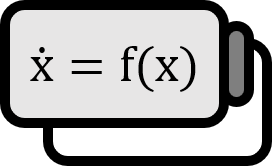SIRV Model: Vaccines and Breakthrough Infections
Overview
The SIRV model is an epidemiological compartment model that adds vaccination to the SIR model.
Model

$$ \begin{align*} {{d S} \over {d t}} =& - {{ \beta } \over { N }} I S - vS \\ {{d I} \over {d t}} =& {{ \beta } \over { N }} S I - \mu I \\ {{d R} \over {d t}} =& \mu I \\ {{d V} \over {d t}} =& vS \end{align*} $$
Variables
- $S(t)$: Represents the number of individuals who are susceptible to the disease at time $t$.
- $I(t)$: Represents the number of individuals who can transmit the disease at time $t$.
- $R(t)$: Represents the number of individuals who have recovered from the disease at time $t$.
- $V(t)$: Represents the number of individuals who have been vaccinated against the disease at time $t$.
- $N(t) = S(t) + I(t) + R(t) + V(t)$: Represents the total number of individuals.
Parameters
- $\beta>0$: The infection rate.
- $\mu>0$: The recovery rate.
- $v>0$: The vaccine supply.
Description
Malaria, mediated by Anopheles mosquitoes, is one of the worst infectious diseases afflicting humanity, with about 200 million people worldwide currently suffering from the disease. One of the strategies to combat Malaria is to extinct the vector, the mosquitoes. If this were feasible, it would have been implemented long ago; realistically, it’s a challenging strategy to execute.
One solution to this complex problem is the use of vaccines and prophylactics. Although it typically requires a long time and doesn’t fundamentally solve the problem, this approach aims to reduce the number of susceptible individuals $S$ to a level that significantly hampers the further transmission of the disease. It’s not about killing the existing susceptible individuals (even if it were possible, killing the infectious individuals $I$ would be more efficient), but rather, through vaccination, converting susceptible individuals $S$ into vaccinated individuals $V$ to indirectly lower the force of infection $\beta S I$.
Herd Immunity 1
Following the above paragraph, when a majority of a group acquires immunity, thereby halting the transmission of a disease, it’s called herd immunity. This term is used whether the immunity is acquired through infection or vaccination, but if it’s the former, it’s more like the group has been defeated by the disease rather than having prevented it. Hence, the term herd immunity typically refers to a vaccination strategy. This notion implies that even if not every individual has immunity, the spread of the disease can still be collectively stopped.
Moreover, the proportion of the vaccinated population within the total group, denoted as $C = V(t)/N(t)$, is referred to as coverage. Naturally, we become interested in the minimum coverage required $C^{\ast}$ to naturally form herd immunity. This essentially means finding the value that lowers the effective reproduction number $\mathcal{R}$ below $1$. The effective reproduction number is primarily calculated by multiplying the basic reproduction number $\mathcal{R}_{0}$ by the ratio of susceptible individuals $S$ in the total population, denoted by $S/N$. If at the onset of an outbreak $N(0) = S(0) + V(0)$, our goal is to find the $$ \begin{align*} \mathcal{R} =& R_{0} {{ S } \over { N }} \\ =& R_{0} \left( 1 - {{ V } \over { N }} \right) \\ =& R_{0} \left( 1 - C \right) < 1 \end{align*} $$ minimum value $C = C^{\ast}$ that satisfies the equation. A simple calculation shows $$ R_{0} \left( 1 - C^{\ast} \right) < 1 \iff C^{\ast} = {{ \mathcal{R}_{0} - 1 } \over { \mathcal{R}_{0} }} $$ For example, the measles outbreak in England and Wales from 1956 to 1968 had a basic reproduction number $\mathcal{R}_{0}$ of around $13$, requiring a minimum coverage of approximately $92 \%$ to combat it2. $$ C^{\ast} = {{ 13 - 1 } \over { 13 }} \approx 92.3077 \cdots \approx 92 \% $$
Variants
Breakthrough Infections

The originally presented model assumes that vaccination grants absolute immunity against the disease. However, in reality, there have been reports of breakthrough infections, where individuals contract the disease despite being vaccinated. If the vaccine effectiveness $\sigma$ is represented between $0$ and $1$, then the model incorporating breakthrough infections can be expressed as follows.
$$ \begin{align*} {{d S} \over {d t}} =& - {{ \beta } \over { N }} I S - vS \\ {{d I} \over {d t}} =& {{ \beta } \over { N }} \left( S + (1-\sigma) V \right) I - \mu I \\ {{d R} \over {d t}} =& \mu I \\ {{d V} \over {d t}} =& - {{ \beta (1-\sigma) } \over { N }} I V + vS \end{align*} $$
In models without considering breakthrough infections, the effectiveness is assumed to be $\sigma = 1$.
